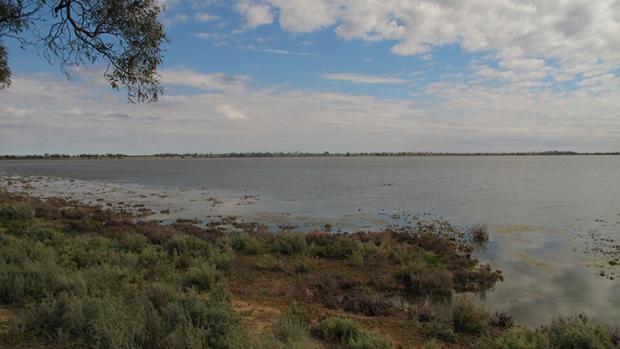Loading
Lake Cullen springs to life

Community support and input has resulted in a rare opportunity to continue to boost one of the region’s tourism hotspots for another year.
The Kerang Wetlands are an internationally recognised and protected tourism Mecca in the north of the catchment, home to tens of thousands of national and international birds, including some of Australia’s most vulnerable species.
Lake Cullen is one of the largest lakes in the wetlands, on the shared floodplains of the Avoca and Loddon rivers. It is valued because of its size and unique environment, which is used extensively by waterbirds to nest and forage for food.
Investigations undertaken during the Millenium Drought suggested Lake Cullen should only hold water when the nearby Avoca Marshes were full. However, community feedback suggested otherwise, so the North Central Catchment Management Authority (CMA) investigated.
“What we found was very little interaction at all between the two water bodies, which was great news,” North Central CMA Water for the Environment Program Manager Louissa Rogers said.
“That presented the local community with a rare opportunity. Locals wanted to see the benefits of the bird breeding, including the tourism benefits, flow on for another year, and asked if water for the environment could be added again.
“We all understand the current conditions are tough, and the local community is working side by side with water for the environment to make the region a better place to live and visit.
“The Loddon Murray Wetlands region is important for the region’s economy, through tourism as well as industries such as bee keeping and timber production. They are also key attractions for recreation, education, cultural connections and social wellbeing.”
The Loddon Murray Wetlands Environmental Water Advisory Group includes local landholders, irrigators, duck hunters and other community members.
“About 30,000 birds were recorded on Lake Cullen in January and March this year, and the community advisory group was keen to give them a chance to survive this year,” Ms Rogers said.
“Lake Cullen’s size means it is a refuge in the region, and with the current dry conditions, its importance is magnified.”
Tourism is worth more than $550 million to the region’s economy, and the Kerang Wetlands are a key tourism hotspot for visitors from around the world.
“Gannawarra Shire businesses benefit to the tune of $26 million a year from tourism, and the wetlands are big attractions. The local community clearly values the wetlands and are keen, even in dry times, to protect them,” Ms Rogers said.
“Since 2017 we have seen endangered birds such as the Australasian bittern and freckled duck, the Near Threatened magpie goose and the vulnerable brolga living at Lake Cullen.
“We have also recorded the very rare black-tailed godwit, which migrates from the northern hemisphere, possibly from as far away as Alaska, and the double-banded plover which comes from across the ditch in New Zealand.
“Putting water in the lake may attract even more birds to the wetlands, underlining the region’s importance on the world stage.”
Lake Cullen will be one of seven of the Loddon Murray Wetlands to receive about 7950 megalitres of water in the coming weeks. Little Lake Meran, Lake Murphy, McDonalds Swamp, Wirra-Lo Wetland Complex, Lake Elizabeth and Round Lake will also benefit from flows.
“With most of the nearby wetlands drying up, Lake Cullen is now taking on extra importance. It is better for all these birds to stay there and breed, than to have to find another home,” Ms Rogers said.
“Environmental water is essential for keeping waterways healthy. Healthy waterways provide ongoing benefits for local communities.”
The flows are in line with the Victorian Environmental Water Holder’s Seasonal Watering Plan 2018-19, which is available to download from www.vewh.vic.gov.au, and regular updates are posted here
